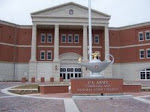 Counterinsurgency in Iraq and Afghanistan has become the US Army’s primary training mission, but does our military have the ability to prepare to fight the next war? This is a very complicated and complex issue that requires input from many experienced leaders; many of these leaders are busy fighting, recovering or preparing to fight one of the two wars. Priory of the manning resources of the US Army is obviously going to the deploying units. The US Army is facing a shortage of officers and therefore the institutional Army bears the brunt of the workforce deficiency. The institutional Army could use some help and perhaps the students in the Command and General Staff College (CGSC) in Ft Leavenworth, KS can provide a quantity of quality support.
Counterinsurgency in Iraq and Afghanistan has become the US Army’s primary training mission, but does our military have the ability to prepare to fight the next war? This is a very complicated and complex issue that requires input from many experienced leaders; many of these leaders are busy fighting, recovering or preparing to fight one of the two wars. Priory of the manning resources of the US Army is obviously going to the deploying units. The US Army is facing a shortage of officers and therefore the institutional Army bears the brunt of the workforce deficiency. The institutional Army could use some help and perhaps the students in the Command and General Staff College (CGSC) in Ft Leavenworth, KS can provide a quantity of quality support.If it has been said once, it has been said many thousands of times: “the most students get out of attending CGSC is the interaction with the other students”. This statement has been as true today and it was when Ft Leavenworth used to host CASSS. As with the now defunct CASSS and today’s CGSC (AKA ILE and SAMS), the attendees are knowledgeable of the material being taught (perhaps by an instructor little more experience) and obtain the majority of the edification from the adult learning process and informal conversations between classes.
ILE attendees are required to research and write approximately 50 papers throughout the ten month course (this does not include those officers completing a masters program). These assignments range from individual to group and from one page to ten. With over 1200 students attending each year, this is over 60,000 reports, or about a quarter of a million pages of work. These assignments are turned in to one instructor who has ten working days to return the graded work, graded on the experience/background of each individual instructor. Regarding these reports, there is typically no cross pollination of intellectual research and discovery between students or the operational Army. The current system is comparable to training on a stationary bike: it is great for the individual, but benefits no one else. Continuing this analogy, it should be possible to link all the stationary bikes to a generator to provide additional power to the institutional Army.
Because of the officer shortages, the institutional Army is taking some of the hardest hits on manning. Doctrine and updated training methods are not keeping up with what is needed by the operational units and leaders. For the first time in over 30 years, ILE is filled with majors with recent on the ground combat/stability operation experience in command and senior staff positions. These students could perhaps be used as think tanks and become directly involved with moving the intuitional Army from continually attempting to keep up with ground truth, to affecting forward thinking.
One suggestion is to task CGSC student sections to review/develop doctrine (example: how should a staff war game COAs for stability (Phase IV) operations); this program has recently been adopted at CGSC, but on a small scale. The idea would be to gather suggestions from the field/branches/school houses to a CGSC committee to coordinate review by the students.
A staff group section (or sections) would be tasked to develop a revised or new method. Other staff groups can then take the new concept and “beta test” the applicability. Results would be sent to the proprietor branch, placed in the professional publications like “Military Review” (conveniently located in Ft Leavenworth, KS), and/or posted to professional blogs.
Another proposal is to require ILE students to contribute to the Center for Army Lessons Learned (CALL). The wealth of experience, from both training and deployments, is not being formally captured on a large scale. Students could also be tasked to review, organize and document the mass amount of information entering the CALL system.
In summary, the Command and General Staff College is an important learning environment for the individual student, but could also become valuable to the greater Army. There are many techniques in which this knowledge power generation system could be adapted with the ultimate goal to ensure every available resource the US Army has is used to support and win the current and future wars of our nation.
GEORGE





1 comment:
Very valid points, George. We are certainly missing a great opportunity for some "think tank" like thinking leading to development of new and better ideas.
Challenge for the military to decide how much individual education do they want each of us to achieve and how much useful products do they want out of us. Since the goal of ILE is to prepare us for the next 5-10 years, we certainly wouldn't want to spend all our time focused on today's problems, but some application of our recent experiences seems reasonable.
MAJ Jake Bruhl (currently at Air Cmd and Staff College)
Post a Comment